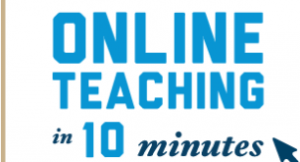 Welcome to GSEHD Online Teaching Resources. On this home page you can find quick links to articles, videos and sites to help you with your online course.If you want to take a deeper dive take a look at the other pages provided in this site. The information and resources have been provided by the Instructional Core. If you need assistance with your online course please contact Lisa Stehman, GSEHD Instructional Designer .
Welcome to GSEHD Online Teaching Resources. On this home page you can find quick links to articles, videos and sites to help you with your online course.If you want to take a deeper dive take a look at the other pages provided in this site. The information and resources have been provided by the Instructional Core. If you need assistance with your online course please contact Lisa Stehman, GSEHD Instructional Designer .
Steps for a Successful Fall Semester Online as Designed by the Instruction Core
- Use course objectives as your guide - and recognize that you may need to do less.
- Move from course objectives to interactions.
- Plan your interactions, considering two key questions.
- Assess what technology is needed to achieve your goals.
- Review best practices for using technology effectively.
- Build class community -- and recognize the unique circumstances of fall.
- Get help or ask a question.
 Online Teaching in 10 Minute Videos: Plan your Course Interactions in a Snap!
Online Teaching in 10 Minute Videos: Plan your Course Interactions in a Snap!
- Creating a Great Discussion Board: Setting Up Boards and Expectations
- Creating a Great Discussion Board: Planning a Strategy and Writing Questions
- Creating a Great Discussion Board: Moderation and Assessment
- Designing Learner-Centered Assessments in Online Environments
- Developing Asynchronous Activities
- Hosting an Engaging Collaborate Sync Session
- Tools for Presentation and Communication in an Online Course
- Tools for Assessment
 What Technology Will You Need, and How to Use It?
What Technology Will You Need, and How to Use It?
- Blackboard for Asynchronous Interactions
- Get started with Blackboard
- Faculty One-Sheet Guides: Browse one-sheet guides created by GW instructional technologists specifically for GW faculty.
- Blackboard Guides: Log in to Blackboard and click Blackboard Guides in the top menu to view video and PDF guides for almost every task in Blackboard.
- Web Conferencing Tools for Synchronous Sessions
GW supports two types of web conferencing technology: Blackboard Collaborate Ultra and Webex. Some schools or instructors may choose to use other web conferencing services, such as Zoom or Blue Jeans. All members of the GW community should follow these privacy guidelines.
- Blackboard Collaborate Ultra
- FAQs on using Collaborate Ultra
- Blackboard Guides: Log in to Blackboard and click Blackboard Guides in the top menu to view video and PDF guides for almost every task in Blackboard.
- WebEx
Webex is available to all GW students, faculty and staff which allows for real-time video meetings and sharing computer content over the web. To begin using your Webex account, login to gwu.webex.comwith your GW email address (NetID@gwu.edu) and corresponding password.
 Make your Sessions Active Using Technology
Make your Sessions Active Using Technology
You can build interaction into your class by using tools built in to your lecturing technology. These can be things like polls and whiteboards to break up sections of lecturing to students, and chat tools that allow remote students to participate and submit questions as well.
Blackboard Collaborate Ultra
WebEx
- Chat
- Polling
- Whiteboard
- Breakout Sessions (only available in Webex Training sessions)
Building community and rapport in your classes is especially important in the Fall 2020 situation, which can require a more intentional approach than in the classroom. Some ways to start are:
- Introduce yourself and make time for students to introduce themselves. This can be done in a live class session or you could set up an Introduce Yourself discussion board where students can post their brief bio, read others, and start to learn who is in their class.
- View or print a photo roster of your students so that you can become familiar with them
- Conduct virtual office hours to meet students individually
- Think of good introductory activities and strategies to introduce your syllabus for Your First Days of Class
- Make opportunities to solicit feedback and accommodate student needs. You can create and share an anonymous feedback survey in Blackboard after the first two weeks of class asking how students are doing, what activities they’re liking, and what could be improved.
Communicating your expectations clearly to your students helps them to avoid the anxiety and stress of trying to interpret your instructions. Be more explicit than you think you may even need to be and it will cut down on student confusion.
- Have an outsider read your syllabus - this could be a colleague, friend, or family member. Someone unfamiliar with the course has a fresh perspective and may be able to help point out areas that could be written more clearly.
- Be clear about what students need for class - not just textbooks but also point them to what technologies you’ll be using in the class (Blackboard, Webex, etc.).
- Communicate class sessions and deadlines with a date, time and timezone. You may have international and remote students attending your class and being clear that deadlines are set to D.C. Eastern time will enable them to participate and turn in assignments on time.
Practice tips for trauma-informed teaching for fall. With fear of infection, financial concerns, and political, social, and economic turmoil to consider, students and instructors will be experiencing an unusually high level of stress. Stress inhibits learning and can cause students to have a harder time planning, remembering, and focusing on what they need to learn.
- Supporting Student Well-Being Online offers strategies for approaching outreach to students as well as Blackboard tools to use for that purpose
Inclusive teaching strives to create a learning environment in which all students have equal access to learning regardless of their background or needs. Students who feel a sense of belonging are more motivated and engaged.
- GW’s Disability Support Services maintains a faculty guide for dealing with student accommodations as well as instructions on universal design.
- Reflect on your teaching and ways that it can be made more inclusive using this Inclusive Teaching inventory - what are you doing already? What can you improve?
- Use the GSEHD Accessibility for Faculty Community in Blackboard to learn more. It can is located in Blackboard under the My Blackboard tab under My Communities. If you do not see it please contact Lisa Stehman to be added.
Help your Students by adding these videos for support in online learning.
- Preparing for Your Online Class
- Getting Organized During Virtual Learning
- Staying Motivated During Virtual Learning
- Great Tips for Asynchronous Discussion
- Tips to Create an Engaging Asynchronous Learning Environment
- How to Caption Your Videos
- Online Teaching Conversation Notes from 6/16 Student Engagement with Dr. Khilji
- Online Teaching Conversation Notes from 6/9 Building Community with Dr. Milman
- Remote Teaching: When and How to Synchronous vs. Asynchronous Methods
- Best Practices for Synchronous Sessions
- Design for Online Blog
Get Help!
Lisa Stehman
- GSEHD Instructional Designer
- 202-994-7210
Instructional Technology Lab
- 202-994-0485
- itl@gwu.edu





